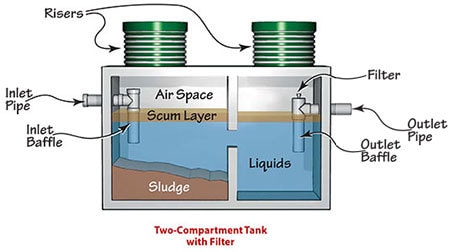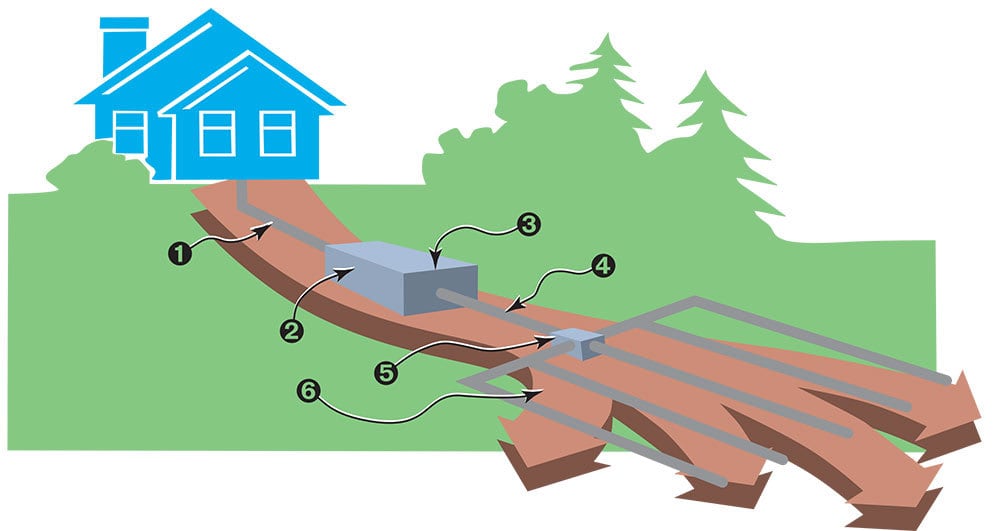Universal Septic provides full service septic pumping, inspection and repair to over 5,000 residential customers. Universal Septic services Fairfield County and parts of New Haven and Litchfield Counties.
Homeowner’s Guide
How a Septic System works
There are six major components:
 1. a house sewer line carries waste to the septic tank
1. a house sewer line carries waste to the septic tank
2. a septic tank that allows the solids to settle and remain in the tank while the liquids flow into the leaching system
3. as of 2000, all septic tanks have been constructed with outlet baffle filters. The filters must be cleaned at the time of septic tank pumping. Filters may require more repeat cleaning if they clog frequently.
4. distribution piping which leads effluent from the tank
5. a liquid distribution box may be used to uniformly distribute effluent through the leaching system
6. a leaching system which may consist of a leaching field, trenches, leaching pits (dry wells), beds or galleries which help purify the effluent by filtration through the soil.

How often should the Septic Tank be cleaned?
Septic tanks should be checked and cleaned regularly. However, if you have a large family, an older septic system or a food disposal, more frequent cleaning of the tank is advisable. Every two to three years is an average interval. Solids, which settle down to the bottom of the tank, are broken down by bacterial action. Eventually, the remaining undigested material, known as “sludge,” accumulates and must be removed. If solids are not pumped out regularly, they will build up to a high level and can be carried from the tank to the absorption field. Those solids will clog the pipes, stone and the soil surrounding them.
For over the last 30 years, Connecticut Public Health Code regulations require that new septic tanks have a minimum capacity of 1,000 gallons and 1,250 gallons if a garbage disposal is installed. 1,250–1,500 gallon tanks are common for a four to five bedroom house. At a use rate of 60 gallons per person/per day— considered average by most plumbers—a family of five uses 109,500 gallons of water a year! If the number of people in the house exceeds the average for that size dwelling (five people for a three bedroom house, for example)—or if the septic tank is smaller than what the state regulations now require— the system should be cleaned every two years until experience indicates a longer period can be allowed.

Common causes of malfunction that can lead to failure
• Neglecting to inspect and clean the septic tank regularly
• Lack of understanding on the proper use of the system
• Poor soil conditions and/or system design or installation
Some signs of failure: sewage odor, sewage discharging to the ground, wet or muddy patches in your lawn, lush green grass, slow draining bathroom or kitchen fixtures, back up of sewage into your house. Sewage running back from your leaching field into your tank at time of cleaning is a sign of malfunction.
Often, most problems can be prevented by simple maintenance. A regular cleaning costs relatively little and can help prevent system failures. If a system failure does occur, it is best to contact the town sanitarian or health officer for instructions as pumping and cleaning alone may not cure the problem.
A failure could require replacing the entire system, which can cost thousands depending on site conditions… to say nothing of the cost of replanting a yard after a system has been dug up or the inconvenience of trying to live in a house without a working septic system.
Homeowners should verify that a cleaner/installer is licensed, and comes well recommended. While there are many state licensed contractors, the name of the contractor that appears in this pamphlet can offer you advice and up-to-date information. These contractors are members of COWRA, an association dedicated to the encouragement of the highest standards of professional performance and integrity.
Through COWRA’s continuing education program, members are kept current on state-of-the-art methods and, where needed, innovative approaches to subsurface disposal systems.

